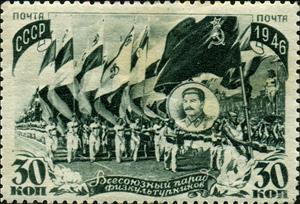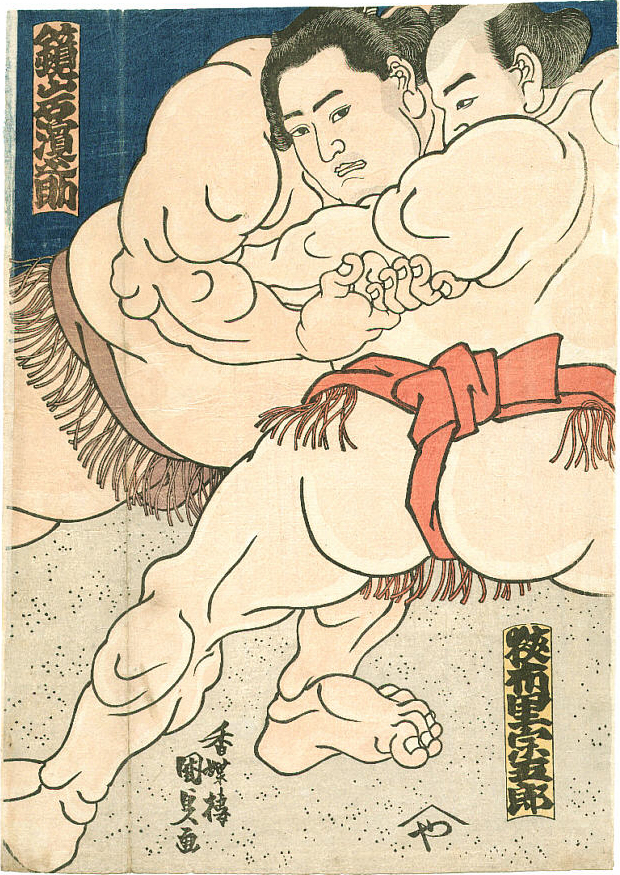Stamp: Athletes carrying flags and portrait of Joseph Stalin (Soviet Union, USSR 1946)
Athletes carrying flags and portrait of Joseph Stalin (Soviet Union, USSR 1946)
01 January (Soviet Union, USSR ) within release 10th Death Anniversary of Maxim Gorky goes into circulation Stamp Athletes carrying flags and portrait of Joseph Stalin face value 30 Russian kopek
| Stamp Athletes carrying flags and portrait of Joseph Stalin in catalogues | |
|---|---|
| Michel: | Mi:SU 1047 |
Stamp is horizontal format.
Also in the issue 10th Death Anniversary of Maxim Gorky:
- Stamp - Medal "For Valiant Labour in the Great Patriotic War" face value 30;
- Stamp - Medal "For Victory over Germany in the Great Patriotic War" face value 30;
- Stamp - Medal "For Valiant Labour in the Great Patriotic War" face value 60;
- Stamp - Medal "For Victory over Germany in the Great Patriotic War" face value 60;
- Stamp - Long Live Our Victory! face value 60;
- Stamp - Coat of Arms of the Soviet Union face value 30;
- Stamp - Spasskaya Tower of the Moscow Kremlin face value 45;
- Stamp - Coat of Arms of the Soviet Union face value 60;
- Stamp - Artillery on Red Square face value 60;
- Stamp - Artillery on Red Square face value 2;
- Stamp - Victory parade on Red Square face value 3;
- Stamp - Pafnuty L. Chebyshev (1821-1894), Russian mathematician face value 30;
- Stamp - Pafnuty L. Chebyshev (1821-1894), Russian mathematician face value 60;
- Stamp - Order of Lenin face value 60;
- Stamp - Medal "Hammer and Sickle" face value 60;
- Stamp - Order of the Red Banner of Labour face value 60;
- Stamp - Order of the Red Star face value 60;
- Stamp - Gold Star medal face value 60;
- Stamp - Order of the Badge of Honour face value 60;
- Stamp - Order of the Red Banner face value 60;
- Stamp - Medal for Battle Merit face value 60;
- Stamp - Medal "For the Defence of the Caucasus" face value 60;
- Stamp - Medal "For Labour Valour" face value 60;
- Stamp - Marshal's Star face value 60;
- Stamp - Medal "For Courage" face value 60;
- Stamp - Medal "For the Defence of the Soviet Transarctic" face value 60;
- Stamp - Medal "For the Defence of Moscow" face value 60;
- Stamp - Medal "For Distinguished Labour" face value 60;
- Stamp - Mikhail I. Kalinin (1875-1946), Soviet statesman face value 20;
- Stamp - Sukhumi face value 15;
- Stamp - Gagry face value 30;
- Stamp - Sochi. Riviera Park face value 30;
- Stamp - Novy Afon face value 45;
- Stamp - Maxim Gorky (1868-1936), Russian author face value 30;
- Stamp - Maxim Gorky (1868-1936), Russian author face value 60;
- Stamp - Athletes carrying flags and portrait of Joseph Stalin face value 30;
- Stamp - Medal "For the Defence of the Caucasus" face value 1;
- Stamp - Ivan the Great Bell Tower face value 5;
- Stamp - Bolshoi Theatre face value 10;
- Stamp - Hotel Moskva face value 15;
- Stamp - Sverdlov Square face value 20;
- Stamp - View of the Kremlin from the Moscow River face value 45;
- Stamp - View of Red Square. Saint Basil's Cathedral face value 60;
- Stamp - Monument of Minin and Pozharsky against the Spasskaya Tower face value 1;
- Stamp - Column of tanks on Red Square, Moscow face value 30;
- Stamp - Column of tanks on Red Square, Moscow face value 60;
- Stamp - A wheat sheaf. Combine harvester. face value 5;
- Stamp - Oil field and rigs face value 10;
- Stamp - Transportation of coal. Miner face value 15;
- Stamp - In the steel manufactory face value 20;
- Stamp - Steelworkers at the blast furnaces face value 30;
- Stamp - Soviet stamps on contour map of the USSR face value 15;
- Stamp - 1st Soviet Postage Stamp face value 30;
- Stamp - Images of Soviet stamps face value 60;
- Stamp - Bas-relief "Lenin and Stalin". Spasskaya Tower face value 30;
- Stamp - Bas-relief "Lenin and Stalin". Spasskaya Tower face value 30;
- Stamp - Bas-relief "Lenin and Stalin". Spasskaya Tower face value 30;
- Stamp - Nikolay A. Nekrasov (1821-1878), Russian poet face value 30;
- Stamp - Nikolay Nekrasov (1821-1878), Russian poet face value 60;
- Stamp - The right side of the badge "Laureate of Stalin Prize" face value 30;
- Stamp - Reconstrusting Dam of Dnieper Hydroelectric Station face value 30;
- Stamp - Reconstrusting Dam of Dnieper Hydroelectric Station face value 60;
Stamp Athletes carrying flags and portrait of Joseph Stalin it reflects the thematic directions:
A head of state (or chief of state) is the public persona that officially represents the national unity and legitimacy of a sovereign state. In some countries, the head of state is a ceremonial figurehead with limited or no executive power, while in others, the head of state is also the head of government. In countries with parliamentary governments, the head of state is typically a ceremonial figurehead that does not actually guide day-to-day government activities and may not be empowered to exercise any kind of secular political authority (e.g., Queen Elizabeth II as Head of the Commonwealth). In countries where the head of state is also the head of government, the president serves as both a public figurehead and the actual highest ranking political leader who oversees the executive branch (e.g., the President of the United States).
A flag is a piece of fabric (most often rectangular or quadrilateral) with a distinctive design that is used as a symbol, as a signaling device, or as decoration. The term flag is also used to refer to the graphic design employed, and flags have since evolved into a general tool for rudimentary signalling and identification, especially in environments where communication is similarly challenging (such as the maritime environment where semaphore is used). National flags are patriotic symbols with varied wide-ranging interpretations, often including strong military associations due to their original and ongoing military uses. Flags are also used in messaging, advertising, or for other decorative purposes. The study of flags is known as vexillology, from the Latin word vexillum, meaning flag or banner.
Sports, are all usually forms of competitive physical activity or games which, through casual or organised participation, aim to use, maintain or improve physical ability and skills while providing enjoyment to participants, and in some cases, entertainment for spectators. Usually the contest or game is between two sides, each attempting to exceed the other. Some sports allow a tie game; others provide tie-breaking methods, to ensure one winner and one loser. A number of such two-sided contests may be arranged in a tournament producing a champion. Many sports leagues make an annual champion by arranging games in a regular sports season, followed in some cases by playoffs. Hundreds of sports exist, from those between single contestants, through to those with hundreds of simultaneous participants, either in teams or competing as individuals. In certain sports such as racing, many contestants may compete, each against each other, with one winner.
An anniversary is the date on which an event took place or an institution was founded in a previous year, and may also refer to the commemoration or celebration of that event. For example, the first event is the initial occurrence or, if planned, the inaugural of the event. One year later would be the first anniversary of that event. The word was first used for Catholic feasts to commemorate saints. Most countries celebrate national anniversaries, typically called national days. These could be the date of independence of the nation or the adoption of a new constitution or form of government. The important dates in a sitting monarch's reign may also be commemorated, an event often referred to as a "Jubilee".




